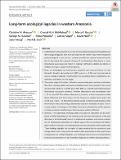Files in this item
Long-term ecological legacies in western Amazonia
Item metadata
| dc.contributor.author | Åkesson, Christine | |
| dc.contributor.author | McMichael, Crystal | |
| dc.contributor.author | Raczka, Marco | |
| dc.contributor.author | Huisman, Seringe | |
| dc.contributor.author | Palmeira, Mona | |
| dc.contributor.author | Vogel, Johnny | |
| dc.contributor.author | Neill, David | |
| dc.contributor.author | Veizaj, Jason | |
| dc.contributor.author | Bush, Mark B. | |
| dc.date.accessioned | 2020-10-08T09:30:06Z | |
| dc.date.available | 2020-10-08T09:30:06Z | |
| dc.date.issued | 2021-01 | |
| dc.identifier | 270163122 | |
| dc.identifier | f6c6800b-e5c9-40b6-884a-3d9e33577caf | |
| dc.identifier | 000577488800001 | |
| dc.identifier | 85091278347 | |
| dc.identifier.citation | Åkesson , C , McMichael , C , Raczka , M , Huisman , S , Palmeira , M , Vogel , J , Neill , D , Veizaj , J & Bush , M B 2021 , ' Long-term ecological legacies in western Amazonia ' , Journal of Ecology , vol. 109 , no. 1 , pp. 432-446 . https://doi.org/10.1111/1365-2745.13501 | en |
| dc.identifier.issn | 0022-0477 | |
| dc.identifier.other | ORCID: /0000-0002-1442-7019/work/81797965 | |
| dc.identifier.uri | https://hdl.handle.net/10023/20742 | |
| dc.description | M.B.B would like to acknowledge funding from the National Science Foundation (grant nos. EAR1338694 and BCS0926973), the Belmont Forum, and the National Aeronautics and Space Administration (grant no. NNX14AD31G). C.N.H.M would like to acknowledge funding from the European Research Council (ERC 2019 StG 853394). C.N.H.M and M.F.R would like to acknowledge funding from the Netherlands Organisation for Scientific Research (ALWOP.322). S.N.H, M.P, and Jo.V performed this research as a part of the BSc research program of the Institute for Biodiversity and Ecosystem Dynamics at the University of Amsterdam. | en |
| dc.description.abstract | 1. Modifications of Amazonian forests by pre‐Columbian peoples are thought to have left ecological legacies that have persisted to the modern day. Most Amazonian palaeoecological records do not, however, provide the required temporal resolution to document the nuanced changes of pre‐Columbian disturbance or post‐disturbance succession and recovery, making it difficult to detect any direct, or indirect, ecological legacies on tree species. 2. Here, we investigate the fossil pollen, phytolith and charcoal history of Lake Kumpaka, Ecuador, during the last 2,415 years in c. 3–50 year time intervals to assess ecological legacies resulting from pre‐Columbian forest modification, disturbance, cultivation and fire usage. 3. Two cycles of pre‐Columbian cultivation (one including slash‐and‐burn cultivation, the other including slash‐and‐mulch cultivation) were documented in the record around 2150–1430 cal. year BP and 1250–680 cal. year BP, with following post‐disturbance succession dynamics. Modern disturbance was documented after c. 10 cal. year BP. The modern disturbance produced a plant composition unlike those of the two past disturbances, as fire frequencies reached their peak in the 2,415‐year record. The disturbance periods varied in intensity and duration, while the overturn of taxa following a disturbance lasted for hundreds of years. The recovery periods following pre‐Columbian disturbance shared some similar patterns of early succession, but the longer‐term recovery patterns differed. 4. Synthesis. The trajectories of change after a cessation of cultivation can be anticipated to differ depending on the intensity, scale, duration and manner of the past disturbance. In the Kumpaka record, no evidence of persistent enrichment or depletion of intentionally altered taxa (i.e. direct legacy effects) was found but indirect legacy effects, however, were documented and have persisted to the modern day. These findings highlight the strengths of using empirical data to reconstruct past change rather than relying solely on modern plant populations to infer past human management and ecological legacies, and challenge some of the current hypotheses involving the persistence of pre‐Columbian legacies on modern plant populations. | |
| dc.format.extent | 15 | |
| dc.format.extent | 2023978 | |
| dc.language.iso | eng | |
| dc.relation.ispartof | Journal of Ecology | en |
| dc.subject | Cultivation | en |
| dc.subject | Disturbance | en |
| dc.subject | Fire | en |
| dc.subject | Maize | en |
| dc.subject | Palms | en |
| dc.subject | Phytoliths | en |
| dc.subject | Pollen | en |
| dc.subject | Succession | en |
| dc.subject | G Geography (General) | en |
| dc.subject | DAS | en |
| dc.subject.lcc | G1 | en |
| dc.title | Long-term ecological legacies in western Amazonia | en |
| dc.type | Journal article | en |
| dc.contributor.institution | University of St Andrews. Environmental Change Research Group | en |
| dc.contributor.institution | University of St Andrews. School of Geography & Sustainable Development | en |
| dc.identifier.doi | https://doi.org/10.1111/1365-2745.13501 | |
| dc.description.status | Peer reviewed | en |
This item appears in the following Collection(s)
Items in the St Andrews Research Repository are protected by copyright, with all rights reserved, unless otherwise indicated.

